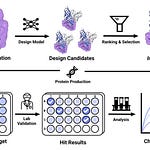Can We Predict Mutational Effects with Just 3D Structure? DeepMVP Tries.
Most mutational effect predictors rely heavily on evolutionary data, which is great if your protein has lots of known homologs but for novel proteins, or fast-evolving ones like viral antigens, conservation-based tools start to break down pretty quickly.
DeepMVP takes a different approach. It predicts the impact of point mutations using only 3D structure. So, no MSAs, no sequence alignments, just atom-level spatial information and surprisingly enough, it works.
Built as a SE(3)-equivariant graph neural network, DeepMVP models the local chemical environment around a mutation site and learns how small atomic changes ripple through the structure. It generalises across species, protein families, and even unseen folds.
Applications and Insights
1. Structure-only prediction with strong accuracy
DeepMVP achieved Spearman’s ρ = 0.63 on the curated S669 benchmark, beating ESM-1v, DeepSequence, and MSA Transformer, even without any evolutionary input. On 48 new SARS-CoV-2 RBD mutants, it correctly predicted antibody escape potential across multiple epitopes.
2. Handles proteins with few or no homologs
On the zero-shot S2648 dataset, DeepMVP ranked mutations with a 0.67 AUC, showing it can generalise even when sequence-based models struggle. This makes it useful for de novo proteins, engineered scaffolds, or under-studied organisms.
3. 3D context matters
Mutations in buried or functionally constrained regions were correctly flagged, even when no conservation signal existed. Predictions used atomic graphs that included bond types, spatial distances, and sidechain orientations within a 12 Å radius.
4. Generalises to multiple fitness readouts
DeepMVP showed strong correlations across different experimental outputs: ρ = 0.63 for abundance, 0.59 for ACE2 binding, and 0.61 for viral replication in SARS-CoV-2. This suggests the model learns a physically meaningful latent space, not just dataset-specific patterns.
I thought this was cool because it addresses one of the biggest bottlenecks in variant prediction: the need for deep alignments. Instead, DeepMVP uses what’s already there: the structure itself.
That opens doors for predicting mutations in designed proteins, new pathogens, or synthetic libraries where MSAs just don’t exist. And because the model is equivariant, it respects the physics of the system, not just statistical trends.
As protein engineering moves into newer, less annotated spaces, this kind of structure-native approach could become a core part of the toolkit. Exciting stuff.
📄Check out the paper!
⚙️Try out the code.
Thanks for reading!
Did you find this newsletter insightful? Share it with a colleague!
Subscribe Now to stay at the forefront of AI in Life Science.
Connect With Us
Have questions or suggestions? We'd love to hear from you!
📧 Email Us | 📲 Follow on LinkedIn | 🌐 Visit Our Website









